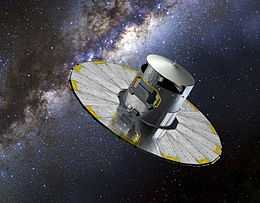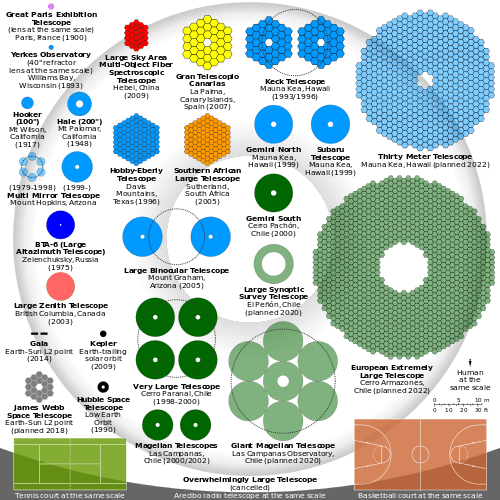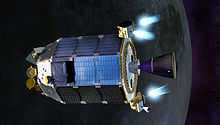Gaia (spacecraft)
 Artist's impression of the Gaia spacecraft | |
| Mission type | Space observatory |
|---|---|
| Operator | ESA |
| COSPAR ID | 2013-074A |
| SATCAT № | 39479 |
| Website |
sci |
| Mission duration |
planned: 5 years[1] elapsed: 1 year, 4 months and 11 days |
| Spacecraft properties | |
| Manufacturer |
EADS Astrium e2v Technologies |
| Launch mass | 2,029 kg (4,473 lb)[2] |
| Dry mass | 1,392 kg (3,069 lb) |
| Payload mass | 710 kg (1,570 lb)[3] |
| Dimensions | 4.6 m × 2.3 m (15.1 ft × 7.5 ft) |
| Power | 1910 watts |
| Start of mission | |
| Launch date | 19 December 2013, 09:12:14 UTC[4] |
| Rocket | Soyuz ST-B/Fregat-MT |
| Launch site | Kourou ELS |
| Contractor | Arianespace |
| Orbital parameters | |
| Reference system | Sun–Earth L2 |
| Regime | Lissajous orbit |
| Periapsis | 263,000 km (163,000 mi)[5] |
| Apoapsis | 707,000 km (439,000 mi)[5] |
| Period | 180 days |
| Epoch | planned |
| Main telescope | |
| Type | Three-mirror anastigmat[2] |
| Diameter | 1.45 m × 0.5 m (4.8 ft × 1.6 ft) |
| Collecting area | 0.7 m2 |
| Transponders | |
| Band |
S Band (TT&C support) X Band (data acquisition) |
| Bandwidth |
few kbit/s down & up (S Band) 3-8Mbit/s download (X Band) |
| Instruments | |
|
ASTRO: Astrometric instrument BP/RP: Photometric instrument RVS: Radial Velocity Spectrometer | |
 | |
Gaia is a space observatory of the European Space Agency (ESA) designed for astrometry.[6][7] The mission aims to construct a 3D space catalog of approximately 1 billion astronomical objects, mainly stars[8][9] (approximately 1% of the Milky Way population)[10] brighter than 20 G magnitudes, where G is the Gaia magnitude passband between about 400 and 1000 nanometres light wavelengths.[11] Additionally Gaia is expected to detect thousands to tens of thousands of Jupiter-sized planets beyond the Solar System,[12] 500,000 quasars and tens of thousands of new asteroids and comets within the Solar System.[6][13][14] The spacecraft will monitor each of its target stars about 70 times over a period of five years.
Gaia will create a precise three-dimensional map of astronomical objects throughout the Milky Way and map their motions, which encode the origin and subsequent evolution of the Milky Way. The spectrophotometric measurements will provide the detailed physical properties of all stars observed, characterizing their luminosity, effective temperature, gravity and elemental composition. This massive stellar census will provide the basic observational data to tackle a wide range of important questions related to the origin, structure, and evolutionary history of our galaxy.
Successor to the Hipparcos mission the telescope is part of ESA's Horizon 2000+ long-term scientific program. Gaia was launched on 19 December 2013 by Arianespace using a Soyuz ST-B/Fregat-MT rocket flying from Kourou in French Guiana.[15][16] The spacecraft currently operates in a Lissajous orbit around the Sun–Earth L2 Lagrangian point.
History
The Gaia space telescope has its roots in ESA's Hipparcos mission (1989–1993). Its mission was proposed in October 1993 by Lennart Lindegren (Lund University, Sweden) and Michael Perryman (ESA) in response to a call for proposals for ESA's Horizon Plus long-term scientific programme. It was adopted by ESA's Science Programme Committee as cornerstone mission number 6 on 13 October 2000, and the B2 phase of the project was authorised on 9 February 2006, with EADS Astrium taking responsibility for the hardware. The name "Gaia" was originally derived as an acronym for Global Astrometric Interferometer for Astrophysics. This reflected the optical technique of interferometry that was originally planned for use on the spacecraft. However, the working method has now changed, and although the acronym is no longer applicable, the name Gaia remains to provide continuity with the project.[17]
The total cost of the mission is around €740 million (~ $1 billion), including the manufacture, launch and ground operations.[18] Gaia was completed two years behind schedule and 16% above its initial budget, mostly due to the difficulties encountered in polishing Gaia 's ten mirrors and assembling and testing the focal plane camera system, as well as other issues.[19]
Objectives
The Gaia space mission has the following objectives:
- To determine the intrinsic luminosity of a star requires knowledge of its distance. One of the few ways to achieve this without physical assumptions is through the star's parallax. Ground-based observations would not measure such parallaxes with sufficient precision due to the effects of the atmosphere and instrumental biases. For instance, Cepheid variables are used as standard candles to measure distances to galaxies, but the accuracy in their own distance measurement is poor. Thus, quantities depending on them, such as the speed of expansion of the universe, remain inaccurate. Measuring their distances accurately has a great impact on the understanding of the other galaxies and thus the whole cosmos.
- Observations of the faintest objects will provide a more complete view of the stellar luminosity function. Gaia will observe 1 billion stars and other bodies, representing 1% of such bodies in the Milky Way galaxy.[20] All objects up to a certain magnitude must be measured in order to have unbiased samples.
- A large number of objects are needed to examine the more rapid stages of stellar evolution. Observing a large number of objects in the galaxy is also important in order to understand the dynamics of our galaxy.
- Measuring the astrometric and kinematic properties of a star is necessary in order to understand the various stellar populations, especially the most distant.
In order to achieve these objectives, Gaia has these goals:
- Determine the position, distance, and annual proper motion of 1 billion stars with an accuracy of about 20 microarcseconds (µas) at 15 mag, and 200 µas at 20 mag.
- Determine the positions of stars at a magnitude of V = 10 down to a precision of 7 μas—this is equivalent to measuring the diameter of a hair from 1000 km away—between 12 and 25 μas down to V = 15, and between 100 and 300 μas to V = 20, depending on the colour of the star.
- About 20 million stars will be measured with a distance precision of 1% and about 200 million will be measured to better than 10%. Distances accurate to 10% will be achieved as far away as the Galactic Centre, 30,000 light-years away.[21]
- Measure the tangential speed of 40 million stars to a precision of better than 0.5 km/s.
- Derive the atmospheric parameters (effective temperature, line-of-sight interstellar extinction, surface gravity, metallicity) for all stars observed,[22] plus some more detailed chemical abundances for targets brighter than V = 15.[23]
- Measure the orbits and inclinations of a thousand extrasolar planets accurately, determining their true mass using astrometric planet detection methods.[24][25]
- Detect the bending of starlight by the Sun's gravitational field, as predicted by Albert Einstein’s General Theory of Relativity, and therefore directly observe the structure of space-time.[17]
- Potential to discover Apohele asteroids with orbits that lie between Earth and the Sun, a region that is difficult for Earth-based telescopes to monitor since this region is only visible in the sky during or near the daytime.[26]
- Detect up to 500,000 quasars.
Spacecraft
Gaia was launched by Arianespace, using a Soyuz ST-B rocket with a Fregat-MT upper stage, from the Ensemble de Lancement Soyouz at Kourou in French Guiana on 19 December 2013 at 09:12 UTC (06:12 local time). The satellite separated from the rocket's upper stage 43 minutes after launch at 09:54 UTC.[27][28] The craft headed towards the Sun–Earth Lagrange point L2 located approximately 1.5 million kilometres from Earth, arriving there 8 January 2014.[29] The L2 point provides the spacecraft with a very stable gravitational and thermal environment. There it uses a Lissajous orbit that avoids blockage of the Sun by the Earth, which would limit the amount of solar energy the satellite could produce through its solar panels, as well as disturb the spacecraft's thermal equilibrium. After launch, a 10-metre diameter sunshade was deployed. The sunshade always faces the Sun, thus cooling all telescope components and powering Gaia using solar panels on its surface.
Scientific instruments
The Gaia payload consists of three main instruments:
- The astrometry instrument (Astro) precisely determines the positions of stars of magnitude 5.7 to 20 by measuring their angular position. By combining the measurements of any given star over the five-year mission, it will be possible to determine its parallax, and therefore its distance, and its proper motion —the velocity of the star as it moves on the plane of the sky.
- The photometric instrument (BP/RP) allows the acquisition of luminosity measurements of stars over the 320–1000 nm spectral band, over the same magnitude 5.7–20. The blue and red photometers (BP/RP) are used to determine stellar properties such as temperature, mass, age and elemental composition.[17][30] Multi-colour photometry is provided by two low-resolution fused-silica prisms dispersing all the light entering the field of view in the along-scan direction prior to detection. The Blue Photometer (BP) operates in the wavelength range 330–680 nm; the Red Photometer (RP) covers the wavelength range 640–1050 nm.[31]
- The Radial-Velocity Spectrometer (RVS) is used to determine the velocity of celestial objects along the line of sight by acquiring high-resolution spectra in the spectral band 847–874 nm (field lines of calcium ion) for objects up to magnitude 17. Radial velocities are measured with a precision between 1 km/s (V=11.5) and 30 km/s (V=17.5). The measurements of radial velocities are important to correct for perspective acceleration which is induced by the motion along the line of sight."[31] The RVS reveals the velocity of the star along the line of sight of Gaia by measuring the Doppler shift of absorption lines in a high-resolution spectrum.
In order to maintain the fine pointing to focus on stars many light years away, there are almost no moving parts. The spacecraft subsystems are mounted on a rigid silicon carbide frame, which provides a stable structure that will not expand or contract due to heat. Attitude control is provided by small cold gas thrusters that can output 1.5 micrograms of nitrogen per second.
The telemetric link with the satellite is about 3 Mbit/s on average, while the total content of the focal plane represents several Gbit/s. Therefore only a few dozen pixels around each object can be downlinked.

- Mirrors (M)
- Mirrors of telescope 1 (M1, M2 and M3)
- Mirrors of telescope 2 (M'1, M'2 and M'3)
- mirrors M4, M'4, M5, M6 are not shown
- Other components (1–9)
- Optical bench (silicon carbide torus)
- Focal plane cooling radiator
- Focal plane electronics[32]
- Nitrogen tanks
- Diffraction grating spectroscope
- Liquid propellant tanks
- Star trackers
- Telecommunication panel and batteries
- Main propulsion subsystem
- (A) Light path of telescope 1

The design of the Gaia focal plane and instruments. Due to the spacecraft's rotation, images cross the focal place array right-to-left at 60 arc seconds per second.[32]
- Incoming light from mirror M3
- Incoming light from mirror M'3
- Focal plane, containing the detector for the Astrometric instrument in light blue, Blue Photometer in dark blue, Red Photometer in red, and Radial Velocity Spectrometer in pink.
- Mirrors M4 and M'4, which combine the two incoming beams of light
- Mirror M5
- Mirror M6, which illuminates the focal plane
- Optics and diffraction grating for the Radial Velocity Spectrometer (RVS)
- Prisms for the Blue Photometer and Red Photometer (BP and RP)
Measurement principles

Despite its name, Gaia does not actually use interferometry to determine the positions of stars. At the time of the original design, interferometry seemed the best way to achieve the target resolution, but the design later evolved into an imaging telescope. Similar to its predecessor Hipparcos, Gaia consists of two telescopes providing two observing directions with a fixed, wide angle (106.5°[33]) between them. The spacecraft rotates continuously around an axis perpendicular to the two telescopes' lines of sight. The spin axis in turn has a slight precession across the sky, while maintaining the same angle to the Sun. By precisely measuring the relative positions of objects from both observing directions, a rigid system of reference is obtained.
The two key telescope properties are:
- 1.45 × 0.5 m primary mirror for each telescope
- 1.0 × 0.5 m focal plane array on which light from both telescopes is projected. This in turn consists of 106 CCDs of 4500 × 1966 pixels each, for a total of one gigapixel.[34][35][36]
Each celestial object will be observed on average about 70 times during the mission, which is expected to last five years. These measurements will help determine the astrometric parameters of stars: two corresponding to the angular position of a given star on the sky, two for the derivatives of the star's position over time (motion) and lastly, the star's parallax from which distance can be calculated. The radial velocity of the brighter stars is measured by an integrated spectrometer observing the Doppler effect. Because of the physical constraints imposed by the Soyuz spacecraft, Gaia 's focal arrays could not be equipped with optimal radiation shielding, and ESA expects their performance to suffer somewhat toward the end of the five year mission. Ground tests of the CCDs while they were subjected to radiation provided reassurance that the primary mission's objectives can be met.
Absolute distance accuracy will range from 20% for stars near the centre of the Galaxy, some 30,000 light-years away, to 0.001% for the stars nearest to our Solar System.[37]
Data processing
The overall data volume that will be retrieved from the spacecraft during the five-year mission assuming a nominal compressed data rate of 1 Mbit/s is approximately 60 TB, amounting to about 200 TB of usable uncompressed data on the ground, stored in the InterSystems Caché database. The responsibility of the data processing, partly funded by ESA, has been entrusted to a European consortium (the Data Processing and Analysis Consortium, or DPAC) which has been selected after its proposal to the ESA Announcement of Opportunity released in November 2006. DPAC's funding is provided by the participating countries and has been secured until the production of Gaia 's final catalogue scheduled for 2020.
Gaia will send back data for about eight hours every day at about 5 Mbit/s. ESA's two most sensitive ground stations, the 35 m diameter radio dishes in Cebreros, Spain, and New Norcia, Australia, will receive the data.[17]
Launch and orbit

In October 2013 ESA had to postpone Gaia 's original launch date, due to a precautionary replacement of two of Gaia 's transponders. These are used to generate timing signals for the downlink of science data. A problem with an identical transponder, on a satellite already in orbit, necessitated their replacement and reverification once incorporated into Gaia. The rescheduled launch window was from 17 December 2013 to 5 January 2014, and Gaia slated for launch on 19 December.[39]
Gaia was successfully launched on 19 December 2013 at 09:12 UTC.[40] About three weeks after launch, on 8 January 2014, it reached its designated orbit around the SEL2 point.[5][41]
The ephemeris of Gaia satellite and the field of view map can be computed with the help of the public dedicated web-interface Gaiainthesky [42] for any location on Earth.
Testing and calibration phase, started while Gaia was en route to SEL2 point continued until the end of July 2014,[43] three months behind schedule due to unforeseen issues with ice deposits and stray light entering the detector.
Stray light problem
Shortly after launch, ESA revealed that Gaia was suffering from a stray light problem, initially thought to be due to ice deposits, causing some of the light diffracted around the edges of the sunshield and entering the telescope apertures to be reflected towards the focal plane.[44] Later, the source of the stray light has been identified as the fibers of the sunshield, protruding beyond the edges of the shield.[45] This will result in a "degradation in science performance [which] will be relatively modest and mostly restricted to the faintest of Gaia 's one billion stars." Mitigation schemes are being implemented to optimise the mission performance.
See also
References
- ↑ "Gia: fact sheet". ESA. 24 June 2013.
- ↑ 2.0 2.1 "GAIA (Global Astrometric Interferometer for Astrophysics) Mission". ESA eoPortal. Retrieved 2014-03-28.
- ↑ "Frequently Asked Questions about Gaia". ESA. 14 November 2013.
- ↑ "Gaia Liftoff". ESA. 19 December 2013.
- ↑ 5.0 5.1 5.2 "Gaia enters its operational orbit". ESA. 8 January 2014.
- ↑ 6.0 6.1 "ESA Gaia home". ESA. Retrieved 2013-10-23.
- ↑ Spie (2014). "Timo Prusti plenary: Gaia: Scientific In-orbit Performance". SPIE Newsroom. doi:10.1117/2.3201407.13.
- ↑ "A billion pixels for a billion stars". BBC Science and Environment (BBC). 10 October 2011.
- ↑ "We have already installed the eye of 'Gaia' with a billion pixels to study the Milky Way". Science Knowledge. 14 July 2011.
- ↑ "ESA Gaia spacecraft summary". ESA. 20 May 2011.
- ↑ "Gaia Science Performance". Rssd.esa.int.
- ↑ "Gaia Science Objectives". European Space Agency. 14 June 2013.
- ↑ "ESA's Gaia... Launches With A Billion Pixel Camera". Satnews.com. 19 December 2013.
- ↑ "Gaia space telescope to detect killer asteroids". thehindubusinessline.com. 19 December 2013.
- ↑ "Announcement of Opportunity for the Gaia Data Processing Archive Access Co-Ordination Unit". ESA. 19 November 2012.
- ↑ "Arianespace to launch Gaia; ESA mission will observe a billion stars in our galaxy". Press releases. Arianespace. 16 December 2009.
- ↑ 17.0 17.1 17.2 17.3 "ESA Gaia overview". ESA.
- ↑ "Gaia spacecraft set for launch on mission to map a billion stars". Theguardian. 13 December 2013.
- ↑ Svitak, Amy, Galaxy charter, Aviation Week and Space Technology, 2 September 2013, p.30
- ↑ Svitak, Amy, Galaxy charter, Aviation Week and Space Technology, 2 September 2013, p.30
- ↑ Perryman, M.A.C; Pace, O. (August 2000). "GAIA – Unraveling the Origin and Evolution of Our Galaxy" (PDF). ESA Bulletin 103.
- ↑ Bailer-Jones, C. A. L. et al. (2013). "The Gaia astrophysical parameters inference system (Apsis)". Astronomy & Astrophysics 559: A74. doi:10.1051/0004-6361/201322344.
- ↑ Kordopatis, G.; Recio-Blanco, A.; De Laverny, P.; Bijaoui, A.; Hill, V.; Gilmore, G.; Wyse, R. F. G.; Ordenovic, C. (2011). "Automatic stellar spectra parameterisation in the IR Ca ii triplet region". Astronomy & Astrophysics 535: A106. arXiv:1109.6237. doi:10.1051/0004-6361/201117372.
- ↑ Casertano, S.; Lattanzi, M. G.; Sozzetti, A.; Spagna, A.; Jancart, S.; Morbidelli, R.; Pannunzio, R.; Pourbaix, D.; Queloz, D. (2008). "Double-blind test program for astrometric planet detection with Gaia". Astronomy and Astrophysics 482 (2): 699. arXiv:0802.0515. Bibcode:2008A&A...482..699C. doi:10.1051/0004-6361:20078997.
- ↑ "GAIA – Exoplanets". European Space Agency. 27 June 2013.
- ↑ "Mapping the galaxy, and watching our backyard". ESA. July 2004.
- ↑ Clark, Stephen (19 December 2013). "Mission Status Center". Soyuz Launch Report. Spaceflight Now.
- ↑ Amos, Jonathan (19 December 2013). "BBC News – Gaia 'billion star surveyor' lifts off".
- ↑ Gaia project team (24 April 2014). "Commissioning update". esa.
- ↑ "The expected performance of stellar parametrization from Gaia spectrophotometry". arXiv. arXiv:1207.6005.
- ↑ 31.0 31.1 Jordan, S. (2008). "The Gaia Project – technique, performance and status". Astronomische Nachrichten 329 (9–10): 875. arXiv:0811.2345v1. Bibcode:2008AN....329..875J. doi:10.1002/asna.200811065.
- ↑ 32.0 32.1 "Gaia Focal Plane". ESA Science and Technology.
- ↑ "Astrometry in Space". ESA Science and Technology. ESA.
- ↑ "Europe Launching Gigapixel Probe To Map Milky Way". Techcrunch science update (Techcrunch). 6 July 2011.
- ↑ "Gaia: Planets and Parallax". lostintransits (lostintransits). 19 December 2013.
- ↑ "ESA’s Gigapixel Camera Now In Space, Will Map the Milky Way in Unprecedented Detail". petapixel reviews (Petapixel). 19 December 2013.
- ↑ "Frequently Asked Questions about Gaia". ESA.
- ↑ "VST Snaps Gaia en Route to a Billion Stars". ESO. Retrieved 2014-03-12.
- ↑ "Gaia launch postponement update". ESA. 23 October 2013.
- ↑ "Soyuz ST-B successfully launches Gaia space observatory". nasaspaceflight.com. 19 December 2013.
- ↑ "Gaia Mission & Orbit Design Gaia Mission Section". Spaceflight101. Retrieved 2013-12-19.
- ↑ "Gaiainthesky web-interface".
- ↑ "Gaia takes science measurements". ESA. Retrieved 2014-07-28.
- ↑ "GAIA - Commissioning Update". European Space Agency. 24 April 2014. Retrieved 2014-06-03.
- ↑ "STATUS OF THE GAIA STRAYLIGHT ANALYSIS AND MITIGATION ACTIONS". 2014-12-17. Retrieved 1 January 2015.
External links
 Media related to Gaia (satellite) at Wikimedia Commons
Media related to Gaia (satellite) at Wikimedia Commons- Gaia mission home
- ESA Gaia mission
- Gaia page at ESA Spacecraft Operations
- Thorsten Dambeck in Sky and Telescope, Gaia's Mission to the Milky Way, March 2008, pp. 36–39
- Gaia Blog
- Gaia pages for the scientific community
- Gaia library
- GAIA Composition, Formation and Evolution of the Galaxy, Report on the Concept and Technology Study, Gaia Concept and Technology Study Report (CTSR)
| ||||||||||||||||||||||||||||||||||||||||||
| |||||||||||||||||||||||||||||||
| ||||||||||||||||||||||||||||||||||||||||||||||||||||||||||||||||||||||||||||||||
| ||||||||||||||
| |||||||||||||||||||||||||||||||||||||||||||
| ||||||||||


